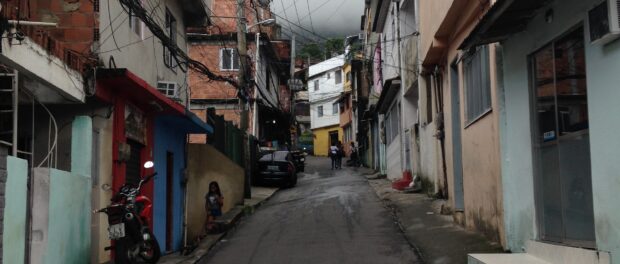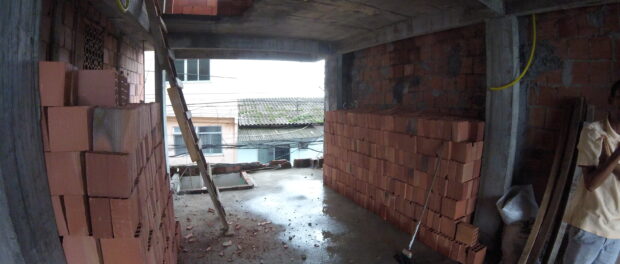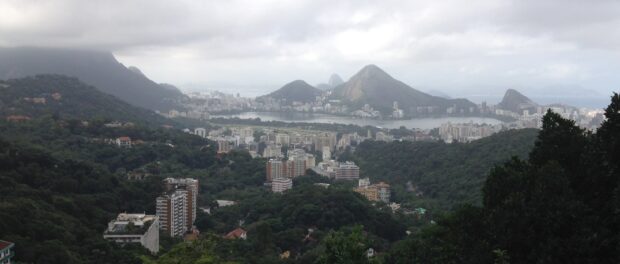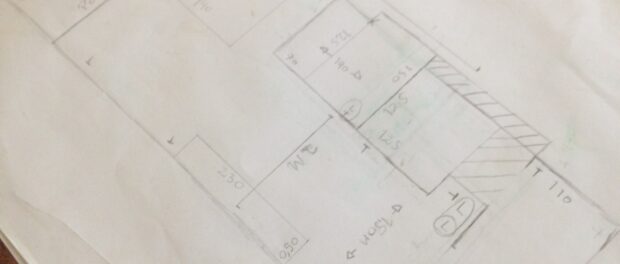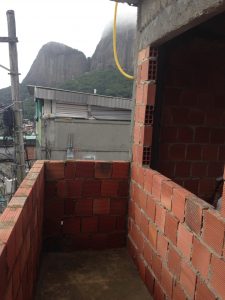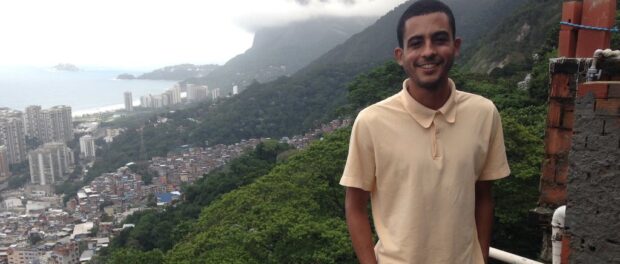
This is Part 2 of the Building the Favela series, a collection of stories of how people build their homes. The informality of Rio’s favelas means residents use their creativity and own know-how to build almost every structure that exists there. This series was born out of the question, “How did you build your home?” to which responses ranged from “We hired a local builder” to “We just… did.” The series aims to show the diversity and complexity of these stories, of which there are millions.
Born in the northeastern Brazilian state of Pernambuco, Diogo Barbosa, 25, moved to Rio de Janeiro with his family when he was two years old. They moved to Vila Laboriaux, a community within the Rocinha favela in the South Zone, at its peak.
“Down in the lower part of Rocinha, there was a place called Campo Esperança, which had a lot of floods and other problems. [The government] decided to build Laboriaux in a place that used to be a small path, a trail really. They built 75 homes here to remove the people who lived in Campo Esperança… It was a peaceful relocation that was, perhaps, even a good thing. The people liked that they were moved within the same neighborhood.”
When Diogo and his family arrived, the 75 original lots still existed but Laboriaux had also begun to expand organically as more people moved to Rocinha. Diogo’s mother married a man from Laboriaux and together they spent many years building the home where Diogo grew up. It opens out to the dense forest of the Tijuca National Park.
Diogo is currently building a home for himself next door to his parents’ house with the help of local builders, a newer tradition in favelas that has arisen with improvements in residents’ economic means. Until recently and still in many cases houses are built through mutirão, or collective action among groups of mutually supportive neighbors.
“They built the house I grew up in together. It took a long time, maybe 15 or 20 years. And here where my house is being built used to be the backyard. It was an empty lot. [The building] kept expanding when my mom built the house for my aunt… She came from Pernambuco state and it was built so she didn’t have to rent, but she might start paying rent soon. And that was the first floor of this house.”
“The second floor was only a roof for many years. And then this one right below me here is the home of my cousin. It was only a roof with a contract that allowed him to build a house here, but leave that part of the roof for my aunt. And this different part of the roof here was always empty. My mom gave it to me and I started to build these last two floors: this one with the kitchen and living room and the [next] one that will be for the bedrooms. It’s a long story, isn’t it?”
Diogo, who is currently unemployed after his restaurant closed, has been in the process of construction for more than a year but described the long process as well worth the effort. He is an organizer with the Favela Verde program offering ecological hikes to visitors through the surrounding forest.
“The first thing, really, was to save money and invest in building the house because the investment is extremely high. You have to decide that you want a house and invest almost all of your income in that. Then you have to contract a local builder, you know? It’s normal to do this. You generally go with people you know and have talked with and then arrive at an agreement of the costs of the project. You work out the material you have to buy and calculate and see if you have money for it and that’s it. Most of the local masons are residents of Rocinha so you know their work in one form or another.”
“The easiest part was investing in the project. Not necessarily saving, but investing and paying. For me it was easy because I know that I will have a large return on the investment in the house. Including if I want to rent or sell the house, everything that I want to do—that I have spent or that I will spend—will never lose its value, it will always increase. So, for me, it’s easy to spend on the house. I made a huge sacrifice for this house. I still don’t have everything I need in my life, but I chose the house as my priority. The most difficult part was managing the project, like all the material, the resources, buying, saving, cleaning, contracting local masons, explaining what I want, you know, and managing all this.”
With incredible views of the Rodrigo de Freitas Lagoon from the front of his home and of the Pedra da Gávea rock formation and all of Rocinha from the back, Diogo explained the factors that influenced the process of designing the house.
“Yeah, the design took work, but I have been thinking about this for a long time; I have been preoccupied with it since I was a teenager actually. I wanted my future home to be comfortable. Because of that, I was always thinking about how it could be made well, but at the same time within a limited space… I am still satisfied with the design today. The kitchen had to be on the street side because I will spend much less time there compared to the living room. I think having to enter through the kitchen is a little annoying, but there is also the noise from the motorcycles and other things that influenced putting the kitchen [on that side]. The living room had to be here [on the other side] because of this.”
Although he spent a long time saving and planning, the process of hiring workers, choosing the materials and managing an ever-changing project is a lot of work.
“Up to now I have spent R$22,000, because it’s two floors. At first my mom, since she came from another generation, wanted me to build only one floor and live just like the house down below. This is cheaper, but I thought about the future and said no, it’s much more comfortable to have the kitchen and living room down here and the bedroom and veranda up top. I think when it’s all done I’ll be even happier I did it this way.
“I switched masons five times I think. One did these columns, one did this first roof, another did the columns on the second floor and another did the columns on [the other] floor. Afterwards I contracted the current mason to waterproof the roof. It turned out well and I decided to contract him to do the brickwork and now all the little things to make it correct. It’s less stress. I also contracted another to do all the pipework and plumbing. After this, I will have to find other people too: one to put the floor down, one to paint, and one to do all the lighting.
“In total, I will spend R$50,000. I’ll get windows, a kitchen counter, and things for the bathroom for a complete house completely painted. It costs a lot, doesn’t it? But I never had all the money at once… I’ve always had what I needed to do the next space. I actually think it is better this way because you think about it more before you do it. Perhaps if I had all the money at once I would do it in a way that wouldn’t actually be my house; it would be the house of the builder or the architect. I also wouldn’t have learned what I learned. I joke with my friends that I will have a hobby now as an engineer or an architect. I also managed the financial part of the project and contact with all the workers. It was a lot.”
Unlike the formal city which has zoning and building codes, construction in a favela involves fewer restrictions, but there is a strong sense of consideration for the neighbors and practical planning.
“I am not allowed to build another story on top; it would be wrong and very tall. The limit here is three floors. The rules are usually enforced by the good sense of the community, primarily because everyone knows that there is a risk with this hill… No one is going to control you, but you have to know what you are doing.”
Diogo has fond memories of growing up in a house so close to nature and having a room for himself and his brother. As for the future, he is optimistic about his home in Laboriaux.
“I want my house to be a two-story home that is super comfortable where I can live my life happily and relax, because it is the place where you spend the most time: eating, relaxing, sleeping, and having visitors, you know? It will be easy with this incredible view to relax and unwind right next to nature.”

